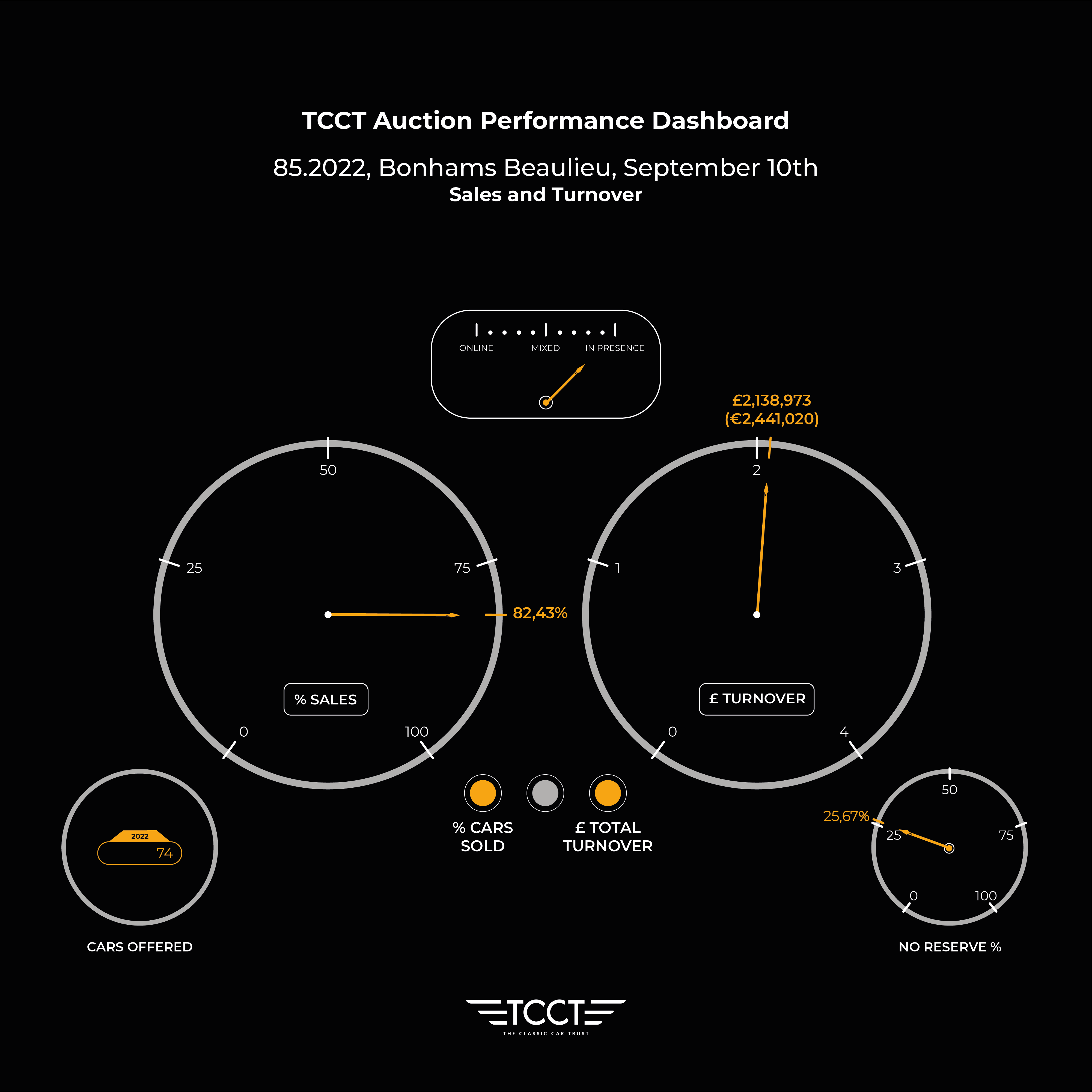Photo credit: Bonhams
Beaulieu is the best-known car museum in the United Kingdom. Opened by Lord Montagu in 1952, it’s also home to the Beaulieu International Autojumble, the oldest car market in the United Kingdom. It’s very similar to a classic “flea market” where old restorers in retirement sell their equipment, widows try to sell the cars of her late husbands and where all marketing is done with a permanent marker pen and a piece of cardboard.

Low prices and correct estimates, many “dark” cars (in need of restoration) create the perfect storm for enthusiasts looking to get their hands a little dirty between gears and books. And so, the “miracle” presented itself again: Bonhams, with 61 cars sold (82.43%) and a turnover of £2,138,973 (€2,441,020) against an original estimate £2,410,500 (€2,750,892) which represents 88.73% in value, all with just one car out of four without reserve, took home yet another great success.

The most expensive car of the sale set off fireworks. The 1955 Aston Martin DB2/4 3.0 DHC was the perfect top lot of the sale: English, 50s, a prestigious brand and a relatively affordable model (not Pebble Beach standards, just to be clear) but above all in need of restoration. The colour scheme was typically English and elegant (green with tobacco interior), left-hand drive, as it was originally exported to the USA. The estimate was very low (£60,000-£100,000) but the hammer price, considering the important restoration needed, was that of an international auction: £172,500 (€196,860).

A similar car and a similar result for the third-most expensive lot of the sale: a 1959 Aston Martin DB MkIII Sports Saloon, also in need of some tender loving care, but much less than the other, so with a slightly higher estimate: £70,000-£110,000. Here too, the market considered the estimate conservative and, after a barrage of bids and raises, closed at £132,250 (€150,925).

But perhaps the most exemplary sales of the event were two cars from opposite sides of the spectrum but each perfectly in line with the spirit. The first: a Rolls Royce 20/25hp Dreadnought Special from 1931. The 20/25hp was a delightful saloon created in the 30s introduced to expand the range downwards that the current market rejects. The word “Special”, however, raised more than a few antennas: it means that the car was originally built in one way and was later transformed with a more sporting vocation. In this case, however, that transformation came very late: in 2014! So a semi-replica with an original chassis from the 30s is not a good start. But this was not the case because the powerful engine, the classically sporty line (it had something reminiscent of a Bentley Blower) and the excellent build quality were perfect for those who want to use it and not to show it at competitions. The estimate of £95,000-£130,000 (high in my opinion) was quickly left in the dust and the hammer dropped at £155,250 (€177,175).

Another car that would have been a flop at any other auction but here shined brightly was the 1909 Daimler TB22 DHC. It was the oldest car of the entire auction, with a small, 3.6 litre four-cylinder engine, too recent for the London-Brighton and too old to be appreciated by the current market and also in need of a complete restoration. The estimate of £20,000-£30,000 was perfectly correct but clearly someone had found the missing pieces at the stalls of the market and went for it: in the end, it sold for £40,825 (€46,590).

Practicality and ease of use also defined two more cars worth looking at. The first was a Morris Minor Pick-up from 1967, restored (very well) in grey with fake black leather and a canvas-like rear deck cover. The estimate of £10,000-£15,000 was justified by the excellent restoration more than by the exclusivity of the model. It changed hands for £17,825 (€20,340).

And that’s not all: a 1976 British Leyland Mini Pick-up followed. The British Leyland brand is a guarantee of… low quality and bad reputation. Yet this example was restored to a high standard and was fitted with the powerful 1275cc engine (by Cooper). Here too the estimate was £12,000-£15,000 but it jumped all the way up to £20,700 (€23,625).

The most curious car of the event was undoubtedly the Ford Model T Caravan from 1914. It was commissioned specifically for a member of the Bentall family, founders of the eponymous British department store chain. Maybe this person wanted to move from one store to another without using hotels, or he was passionate about nature. The fact is that he had the chassis stretched and created a wooden travellers’ caravan-style body complete with a bed and even a wood-burning stove…). In short, in 1914 they created the first campervan. It’s hard to assess this piece of history and, prudently, they estimated it between £20,000-£30,000, but passion prevailed and eventually it changed hands for £63,250 (€72,180).
